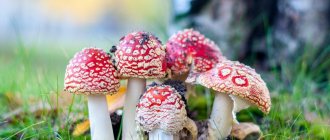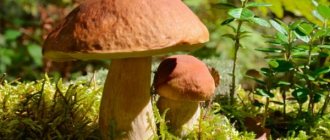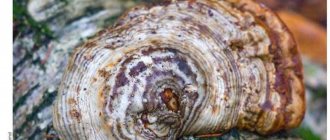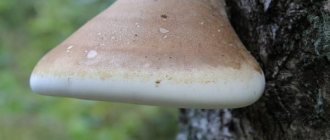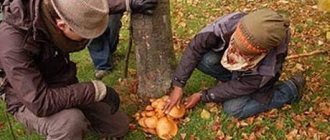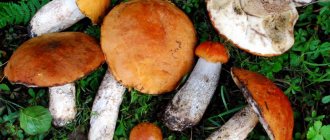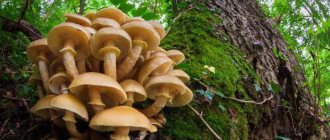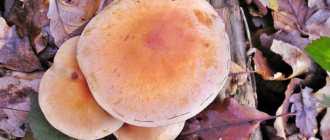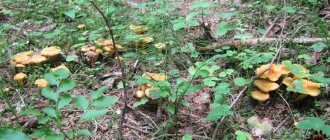Mushrooms in the Leningrad region 2022 is a topic that is raised annually by all lovers of quiet hunting. In order to collect full buckets of tasty trophies, you don’t need to travel far; in fact, in the Leningrad region there are hot spots that, depending on the season, are rich in certain types of mushrooms.
Mushroom places in the Leningrad region now 2022
The first thing that needs to be said is that collecting tasty trophies is becoming more dangerous every year due to the construction of new roads, factories and the high level of pollution in rivers and other types of reservoirs, near which many mushrooms could previously be found. The latter tend to absorb toxins, accumulate them, turning into food hazardous to health. When going on a quiet hunt in the Leningrad region, focus on hot spots that have been tested by experienced mushroom pickers:
- Priozersky district, within which Sosnovy Bor is located. You can get here by driving along the Vyborg Highway.
- The village of Sosnovo, where you go by train from St. Petersburg, Finsky Station. Full buckets of trophies are guaranteed in Sosnovy Massif.
- The village of Kirillovskoye, where there are many clearings in the forest area. You can get here by train or by car if you travel through Scandinavia.
- Sosnovy Bor near Vsevolozhsk district. You will have to drive approximately 118 kilometers from this area; you need to navigate using a map or navigator.
- Forests of the Luga region, which is located next to the lake, to the south of it.
- The village of Zakhodsky, where trains go. The number of edible mushrooms here is impressive.
Milk mushrooms: types, benefits
The breast is considered a real Russian mushroom. In Western, Eastern and Southern countries they don’t even know about them.
In our region, these mushrooms were able to firmly enter the consciousness of every person. They are considered the most wonderful forest gift, and therefore have won the hearts of our compatriots.
In many regions of Russia, for example, in Siberia, these mushrooms were one of the types of industrial mushrooms for a long period of time. Ideal nutritional properties combined with widespread fruiting are why they are in demand among people.
The main purpose of the mushroom is pickling. Other dishes must be prepared from salted preparations. But mushrooms are not suitable for frying, stewing and other similar cooking methods.
Milk milk contains so much protein that it can easily replace meat. The particular benefit of the mushroom is that it is used to create drugs that fight tuberculosis. After all, the components of the mushroom are able to neutralize the dangerous Koch bacillus. Next, we will consider in detail the types of mushrooms.
Where to look?
It is not necessary to rely only on the above mushroom places. General guidelines can also be taken as a basis for quiet hunting in the Leningrad region. The majority of edible mushrooms here are located in mixed forests or pine forests. It is better to go there with the beginning of the mushroom season, in the fall. Of course, you can collect trophies in the spring, as well as in the summer, but you need to prepare for the fact that there will be less fruit than usual even in green areas.
Those mushroom pickers who are afraid to go in search of new mushroom glades without exact coordinates can protect themselves to the maximum by going on a quiet hunt within the Zerkalny area, where you can find the purest forest areas. You can find out more about this place online thanks to forums and mushroom picking clubs.
Collection rules
Any person who goes into the forest to pick mushrooms or berries must know and follow certain rules and have certain things with them:
- water supply and sandwiches;
- matches;
- sharp knife;
- compass;
- basket;
- remedies for mosquito bites.
Irina Selyutina (Biologist):
How to dress properly when going mushroom picking? This question worries many people for good reason, because to a large extent your choice of clothing will directly depend on your well-being, therefore:
- You should dress according to the weather. If clothing is chosen correctly, it will not restrict movement and will protect against blood-sucking arthropods. Must have long sleeves and a closed neck. A scarf or headscarf is suitable to protect your neck. Of course, the ideal option is a camouflage army uniform. Don’t rely too much on repellents - their validity in a forest or other open area is usually no more than 1 hour.
- Shoes - boots, combat boots or sneakers, but in no case flip-flops or sandals.
- You can take a disposable plastic raincoat with you.
- A headdress must be worn on the head - protection from arthropods and weather conditions.
If children go with you to pick mushrooms, dress them brightly so that they can see even with peripheral vision. But it’s still not worth taking children to the training ground: it’s difficult to keep track of them and there are more dangers here than when visiting the forest.
Before you go on a hike, you need to find out where in the area the harvest will be richer and safer. This will be your “reconnaissance”.
It is worth consulting with someone who has been to the area more than once. Perhaps there are inactive landfills nearby and you can walk on them, but more often it is unsafe to be at landfills, the soil there is contaminated, so it is better not to touch the plants and mushrooms on them.
Basic collection rules:
- take only those mushrooms that you are confident in;
- do not take specimens damaged by pests;
- re-sort the house.
Have the mushrooms gone, what they write on the forum?
At the forum of mushroom pickers in the Leningrad region, they discuss the main types of mushrooms that have recently been bearing fruit well in this region. Experienced lovers of quiet hunting indicate that those who go for:
- Honey mushrooms;
- Oyster mushrooms;
- Boletuses;
- Veselki;
- Morels;
- White mushrooms;
- Butter;
- Chanterelles.
It is more difficult to find Truffles, however, such mushrooms germinate in the Leningrad region. The main thing is not to confuse edible types of mushrooms with their counterparts.
The Leningrad region is “rich” in Yellowing Champignon, False Honey Mushrooms, Fly Agarics, Toadstools, Strings. All types of mushrooms are hallucinogenic and poisonous.
Classification of mushrooms by season
The forests of the 47th region are rich in harvest not only at the height of the mushroom season - late August and September, but also in early spring in April. April is the debut month for stitches and morels. In the summer months, the forest will also not leave mushroom pickers without a “catch”. The first boletus and boletus will begin to appear in June, they will be replaced by white boletus and boletus. July will delight mushroom pickers with red beauties - chanterelles, boletus, saffron milk caps and colorful russulas. Most of the mushrooms dominate in August - early September: boletuses, porcini mushrooms, honey mushrooms, chanterelles, volushki and white mushrooms, milk mushrooms.
Expert opinion
Gennady Sergeevich Rylov
A great expert in mycology and an avid mushroom picker. Knows everything about mushrooms, their types and places of growth
Mushrooms are not flowers! You can't pull them out of the ground. Carefully cut off the stem without damaging the mycelium, or twist the mushroom. It is better to collect mushrooms in wicker baskets, so they will retain their presentation.
Spring harvest mushrooms
As soon as the air temperature stops dropping below -10 C and stabilizes, the first spring “snowdrop mushrooms” will begin to overcome the bad weather. At this time, it is best to look for them in the forest, in sun-warmed meadows and hills, in young grass, as well as tree trunks.
- Morel cap and conical morel
Morel cap
Undoubted champions of the spring harvest. These attractive mushrooms with amazing flavors peak at the end of May. The caps are wrinkled and resemble walnut kernels in appearance. The color scheme depends on the age of the fruiting body. The lighter the cap, the older the mushroom.
Morels prefer moist, but at the same time sun-warmed soil, so in early spring they can be found in last year's foliage, near streams, holes and ditches with water, near forest roads. They grow in groups, mainly in deciduous forests (aspen or birch), as well as coniferous and burnt forests.
Morels have a rather cute friend - the common string. Prefers mixed or coniferous forests, young pine plantings. Most often it can be found in well-warmed areas of the forest, near forest roads and ditches, in clearings, among snags, stumps, dry branches and birch bark.
In late spring, with May frosts, the productive layer of strings and morels shifts to the end of May, beginning of June.
Conical morel
- Strobilurus
They grow in pine forests, spruce forests and forests mixed with pine. They appear in early spring in April and begin to grow abundantly in groups in May. They grow on fallen and submerged cones. Only the cap of these mushrooms is edible.
Strobilurus edible
- Oyster mushroom
Without a pronounced mushroom aroma and taste. Prefers rotting birch or aspen wood, but can be found on diseased trees and stumps, in large groups, from May to September. The lingual head is small, fan-shaped, white-gray in color. The leg is lateral, hairy. Only young mushrooms are eaten; with age, the flesh becomes hard and the fruiting body turns yellow.
All oyster mushrooms are edible, but the variety with orange caps is very bitter, so you should not eat it.
Autumn oyster mushroom
- Raincoat
Conditionally edible mushroom of the Champignon family. It is edible only for the first few days, while the body is pear-shaped, white and slightly spiny. Prefers open clearings with grass, meadows and forests with coniferous or deciduous soil. Fruiting peaks in June and begins to appear at the end of May. Large groups can be found until the end of September. They are consumed as food on the first day after collection.
Pear-shaped raincoat
- Summer honey mushrooms
An edible mushroom that literally sticks around rotten stumps or rotting wood like a bracelet. Loves moisture. The first honey mushrooms appear in the warm season: late May and early September. In deciduous or coniferous forests. Peak fruiting occurs in the second half of summer. A characteristic feature of these mushrooms is their aroma with a slightly perceptible honey note. The mushroom cap is wide and dark, the stem is straight and long, dark brown in color.
“Autumn” honey mushrooms, unlike their “summer counterparts,” prefer living trees, being a kind of “parasite invader” for them.
Summer honey fungus
Summer harvest mushrooms
In the summer, without waiting for autumn, mushroom pickers' baskets begin to fill with noble specimens, and mushroom harvests gain momentum. From the second half of July, the activity of boletus and boletus, chanterelles and russula increases, and at the end of the month porcini mushrooms begin to join them. Starting in August, autumn honey mushrooms become active. If the weather is favorable, mushrooms can be found anywhere: under trees, in clearings, along forest roads, ditches and even city squares.
- Oiler
Fruits in dense groups. The peak occurs at the end of summer. However, with an early and warm spring, brown, red-brown or yellow-brown caps begin to appear at the end of May. Night frosts will push back their first appearance to the end of June. Prefers young pine forests or forests mixed with pine trees, well-warmed places on the edges and clearings, and sandy soils.
Real oil can
- Russula
Perhaps the most picky mushroom inhabitant, doing well in both coniferous, deciduous and mixed forests. It can be found in almost any forest, even during months without mushrooms. However, it is precisely in such months that russulas are mainly collected, when there is nothing else to profit from in the forest. Mushrooms begin to appear in early June, but the layer grows more actively in late summer and autumn. The color scheme of the caps is very diverse, but all types are edible.
Russula food or Russula edible
- Boletus (boletus)
An edible mushroom whose name speaks for itself. The first mushrooms appear in birch forests in June. It grows both singly and in small groups. The obabka has a very fast growth rate, ripening by the 6th day, it completely loses its value and appearance. Swamp boletuses have light gray colored caps, while the caps of coffin boletus and common boletus have brownish-brown colors, up to dark brown.
boletus
- Boletus (redhead)
A well-known edible mushroom with stocky legs and yellow-brown or red-brown caps. The first mushrooms appear at the end of June; as a rule, these are spikelets with yellow-brown or white caps. They live in aspen and mixed forests. By mid-summer, the forest pleases us with red boletuses. In the dry season they coexist with aspens, oaks and birches. At the end of summer and autumn, pine and spruce redheads, inhabitants of spruce-birch forests and pine forests, take their watch.
In all representatives of boletuses, the cut flesh quickly turns blue and then turns black. False boletuses turn pink and brown when cut.
Red boletus
- Yellow chanterelle
A favorite of mushroom pickers for its wormless, bright caps and rich taste. Loves mixed and deciduous forests. It grows in numerous groups in damp places among grass, moss and last year's leaves. The first layers of bright orange inverted umbrellas begin to appear already in June, the later mushrooms show themselves to the world in September. In mushroom years they break yield records.
From mid-September, the forest is actively filled with funnel-shaped (tubular) chanterelles, which can be collected even in frost. The texture of their pulp is more delicate than that of the yellow chanterelle, but the taste qualities are completely the same.
The fox is real
- White mushroom (boletus)
A favorite of baskets, every mushroom picker “hunts” for fleshy fruiting bodies. Spruce and pine representatives of this species are the most valuable specimens. With stocky, dense legs and chocolate-brown caps. They usually grow in spruce and pine forests, under birch trees. In dry summers they prefer shady and damp thickets; in rainy summers they settle on sunny edges. Peak fruiting occurs in late summer and autumn.
False mushrooms, which are similar in appearance to edible boletus mushrooms, always turn pink when the flesh is cut. In addition, their fruiting bodies are not wormy.
Porcini
- Gorkushka
An unpretentious conditionally edible mushroom, an inhabitant of deciduous and coniferous forests with mossy places. Lamellar mushrooms with red or brown caps with a convex tubercle in the center. After cutting, a grey-white, watery, milky juice is immediately released. You can collect bitters at the end of June, right up to the snowfall. It usually grows in groups of 10-15 specimens.
Gorkushka
- Valuy (pig, snotty)
A conditionally edible mushroom, it prefers dense and moist deciduous forests, birch and pine forests. Selects edges, forest edges, grass and shaded areas of the forest. Favorite of slugs. The cap is light brown in color and has the shape of a hemisphere with a slippery surface. A yellowish liquid is secreted on the back of the plate. Appears in July. Young valui are collected until October.
Valuy
- Blushing umbrella and white umbrella (field)
Edible delicious mushroom of the Champignon family. Young specimens have an ovoid-shaped cap; as they grow, the cap grows and becomes flat, resembling a wide bell with a dark elevation in the center and a scaly pattern. Prefers bright and open places in the forest (clearings, edges, clearings, meadows). Grows in groups, rows or circles. The first mushrooms appear already in June, and umbrellas are collected until October.
Very often this mushroom is confused with the stinking fly agaric and other inedible varieties of umbrellas.
Umbrella blushing
- Golden scale
An edible mushroom, the value of which is the semi-spherical fleshy caps of bright yellow shades, with a scattering of “rusty” scales. Young fruits are brighter with upturned cap edges. At high humidity, the surface of the mushroom becomes slippery. It grows in clusters on the trunks of birches and tree-like willows, as well as stumps. Collected from July to November.
Other types of flakes are unsuitable for food due to their bitter taste.
Golden scale
In addition to the above representatives, mushroom lovers can diversify their menu:
- Whites and mokrukhas.
- Polypores and oaks.
- Polish mushrooms and goats.
- Hygrophorus late.
Autumn harvest mushrooms
September is the most prolific month of autumn, although mushroom caps are harder to see in the bright foliage. This is the time of porcini mushrooms, boletuses, moss mushrooms, chanterelles, as well as corned beef: honey mushrooms, milk mushrooms, boletus and saffron milk caps. If October brings warm weather, you can look for mushrooms under trees and near stumps. But many mushroom pickers close the “hunting season” during this month and put away their baskets until next year.
- Black milk mushroom
They love light, mixed and deciduous forests. They are found at the edge of the forest and forest edges, along roads and forest paths. Peak fruiting occurs in August and early September. They grow up in huge families.
Black milk mushroom
- Volnushka
It grows in all forests where birches grow, starting in mid-summer. Most moths prefer open areas with sufficient light. In dry times, they feel great under dense bushes or trees, in spruce forests and even windbreaks.
Volnushka pink
- Pine mushroom
It lives next to pine and spruce, and has a special love for young pine growth. Prefers edges and hills, hiding in short grass and under leaves on the north side of trees. Always grows in colonies of specimens of different ages.
Pine mushroom
Along with edible mushrooms, many of their insidious inedible counterparts and poisonous counterparts grow in the forest. Before you indulge in the mushroom frenzy, study false mushrooms to accurately identify their insidious disguise as their edible companions.
Map photo
Mushrooms in the Leningrad region 2022 go looking and, focusing on the general map, where the following are highlighted:
- Priozersky district;
- Sosnovo with its mixed forests;
- Losevo, where not far from Vuoksa moss mushrooms, a lot of boletus mushrooms, a lot of porcini mushrooms and oil caps sprout;
- Volkhovsky district, rich in chanterelles, boletuses, rich in porcini mushrooms (go to Chernoushevo, Kiselnoye, Kolchanovo village);
- Vyborgsky district, where hot spots are concentrated near Lake Zerkalnoe or near the village of Ryabovo;
- the Karelian Isthmus, pleasantly surprising with the variety of noble mushrooms;
- forest areas near Myllyupelto (no further than Pochinok, Motorny or Solnechny), where it is most convenient to get to by your own car;
- Podporozhsky district, where the village of Verkhniye Mandrogi remains the most popular among experienced mushroom pickers;
- Lodeynopolsky district, where people go for porcini mushrooms, boletus mushrooms, and boletuses mainly in the direction of the village of Alekhovshchina;
- Luzhsky district, not further than the village of Serebryansky.
What poisonous mushroom can be confused with milk mushroom?
The milkweed, which has a gray-pink color, is very similar to the white milk mushroom. It should not be eaten as it is considered deadly to the human body.
This mushroom has a cap up to 12 cm wide, dense, fleshy, convex or flattened in the form of a funnel. From the very beginning, the cap of the mushroom has bent edges, which eventually droop, dry out, and become covered with small scales. As the mushroom ages, its cap becomes bare, becomes red, pink or pink-brown, and after drying, blurry spots appear on the cap.
Milky
The leg of the milkweed is dense, up to 8 cm long and up to 4 cm wide. The shape is in the form of a cylinder. The flesh of the mushroom is yellow with a red tint. The bottom of the leg is colored reddish-brown. The milkweed grows from mid-summer to mid-autumn.
Video reviews
According to reviews from experienced quiet hunting enthusiasts, finding a lot of edible trophies in the Leningrad region is not a problem. The main thing is to familiarize yourself with the mushroom map in advance and plan your route. In addition to the most popular places, you can highlight Berngardovka, New Devyatkino, Pukhlovo and the 49th kilometer area, in particular Semerino, in the Gatchinsky district.
Mushrooms in the Leningrad region 2022 is a topic that needs to be given maximum attention so that in the future quiet hunting will bring pleasure and an abundance of trophies.
How to distinguish a black milk mushroom from a pig?
- The pig mushroom is considered to be a lamellar mushroom. It differs from the milk mushroom in that the size of its cap is 20 cm
- The young mushroom has a convex, and over time flat, funnel-shaped, velvety, yellow-brown cap
- The flesh of the mushroom has a light brown tint, which darkens after cutting.
- The plates of the mushroom in the lower part are connected by cross veins
- These veins can be separated from the cap without any problems
pigs
- Leg length is narrow, plain, approximately 9 cm
- It is located in the center or slightly to the side
- As a rule, the mushroom is found in a variety of forests, in the form of large groups
- Breeding period is from mid-summer to mid-October
A fat pig has a larger size. Its color is dark brown, and the stem of the mushroom is velvety. In the first and second types, a large number of harmful compounds accumulate, including heavy metals.
Late mushrooms in November
In November there is a chance to find rare mushrooms. For example, during this month, winter honey fungus , which is more often found on weakened trees near streams. Its important feature is that it retains its taste even after freezing and thawing.
The lucky ones are the ones who stumble upon a white truffle . It is difficult to find because only a small part of its cap sticks out on the surface of the earth. The main part of the truffle is in the soil. Few mushroom pickers will even notice such an inconspicuous tubercle. Gourmets value truffles for their meaty taste.
Danger of collection at a landfill
Fungi are special organisms that absorb all kinds of toxins from the environment. Therefore, even edible and familiar specimens can cause poisoning.
Landfills are among the most dangerous places for collecting forest meat. Even where holiday villages have now appeared, the toxic substances have not yet evaporated from the soil. Mustard gas, phosgene and sarin were sometimes stored in such warehouses during the Soviet era. Liquid phosphorus and arsenic compounds were then simply buried in the ground; at present it is impossible to accurately find and disinfect such a place, because maps of this plan simply were not made.
Half-rotted fences and rusty signs indicate old shooting ranges, military bases or airfields.
They will mark those places where you cannot go. In the Moscow region Chkalovka and Kubinka there were underground lenses with oil and kerosene reserves. The soil in these places is still saturated with chemicals. Fruiting bodies cut in such an area will not do any good.
In addition to landfills, it is dangerous to collect mushrooms near the following places:
- near cities;
- near the railway track;
- near highways;
- next to a landfill;
- near oil storage facilities and factories;
- near agricultural land;
- in the area of Chernobyl and other nuclear power plants.
If you move half a kilometer away from the road, the collection will become safe, but it is better to increase this distance, if possible, to 3 km. The proximity of agricultural land is dangerous because pesticides and other chemicals are often used there, which fall into the ground and, together with groundwater, spread throughout the area, infecting fruiting bodies belonging to representatives of different species growing nearby.
When picking mushrooms, remember that if summer or autumn turns out to be dry, you should not immediately rush to pick mushrooms as soon as they appear after the first rains. There is a high probability that the vegetative body of the fungus (mycelium) has absorbed toxic compounds that entered the soil with rainwater. Better wait for the next rain.
Life hacks and conclusions from experienced mushroom pickers
- It is worth exploring the forest areas near St. Petersburg first.
- You need to go for fruits in the fall, after the first rains: the peak of fruiting occurs in mid-autumn: the end of September and all of October.
- Most often, mushrooms grow in groups, so if you find a successful one, carefully explore the surrounding area.
- It is necessary to harvest the crop in a basket with free air circulation, which will ensure long-term preservation.
- You cannot collect unfamiliar species to avoid poisoning; Experienced mushroom pickers collect only those mushrooms that they know very well.
- You should choose collection sites away from the city and highways, since mushrooms strongly absorb toxins from the soil.
- Many of the inedible specimens are quite easily confused with good mushrooms, and in order not to be poisoned, you need to know the main distinguishing characteristics of their counterparts.
- Inedible species are thought to grow at the same time as the ones they most resemble.
- The coniferous forest belts located near the village of Sosnovo, as well as the forests near Snegirevka, are full of especially poisonous mushrooms.
- The main rule of a mushroom picker: if you’re not sure about a mushroom, don’t take it!
Mushroom picker calendar by type of mushroom
| Types of mushrooms | April | May | June | July | August | September | October |
| Morels | X | X | |||||
| Saffron milk caps | X | X | X | ||||
| White gr. | X | X | X | X | |||
| Russula | X | X | X | X | X | ||
| boletus | X | X | X | X | X | ||
| Butter | X | X | X | X | X | ||
| Honey mushrooms | X | X | X | ||||
| Valui | X | X | X | ||||
| pigs | X | X | X | ||||
| Volnushki | X | X | X | X | |||
| Champignon | X | X | X | X | |||
| Rows | X | X | X | ||||
| Polish gr. | X | ||||||
| greenfinch | X | X | |||||
| Boletus | X | X | X | X | X | ||
| Flywheels | X | X | X | X | |||
| Chanterelles | X | X | X | ||||
| Milk mushrooms | X | X | X | X | |||
| Serushki | X | X | X | ||||
| Bitters | X | X | X | X | X | ||
| Belyanki | X | X | |||||
| Kozlyaki | X | X |
This year, according to experts, mushrooms were very numerous in the spring. But the same cannot be said about the summer; it turned out to be mediocre, although much better than last year. In summer, mushrooms grow in spots.
In the first 2 weeks of September, a massive growth of porcini mushrooms, aspen mushrooms, boletus mushrooms, and autumn mushrooms takes place in the Leningrad region. It’s quite early to say whether this year was a mushroom year. But you can already gather some things. Note that there are mushrooms in all areas of the Leningrad region, you need to be guided by the type of forest. Look for forests with aspen, birch, and spruce trees.
Rospotrebnadzor: how not to get poisoned by mushrooms
Every year in the Russian Federation, about a thousand victims of mushroom poisoning are registered, of which 30% of cases are fatal. Mushroom poisoning is most severely experienced by people with poor health and chronic diseases.
Children suffer even more severe poisoning. Mushrooms, in general, are edible and even the highest quality ones are difficult for a child’s body, which does not have the necessary amount of enzymes to digest them. That is why it is not recommended to feed mushrooms to children and children under 14 years of age.
We are talking about forest mushrooms, which can also poison adults.
To avoid bad consequences, it is important to follow precautions, which you can learn from the table below
Suitable months for quiet hunting
It is believed that one should go for mushrooms in the fall. This is due to the fact that at this time it rains more often, which means that delicious forest delicacies grow most actively.
In fact, experienced mushroom pickers begin stocking up already in the summer. If the weather is not hot, then good mushroom harvests are collected in July and August. Although in June, boletus and boletus mushrooms, which are nutritious and tasty, already begin to actively grow.
In September, after the start of the rainy season, almost all mushrooms begin to grow rapidly.
In October , the mushroom season begins to decline . Therefore, to fill the basket, you have to go further into the forest and first of all pay attention to stumps and trees. Warmth and moisture remain there longer, and this is what mushrooms need for growth.
